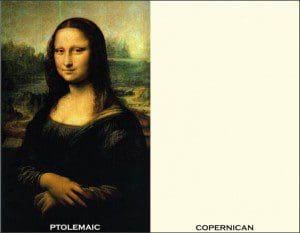"Maybe we invented him. He’s that unlikely, you know", says Bruce Sterling of Jonathon Keats in his Wired blog Beyond the Beyond, where he often talks about Mr. Keats' work under the headline "The latest from Jonathon Keats".
This time Mr. Sterling was talking about The First Copernican Art Manifesto, an exhibition that took place at Modernism Gallery in San Francisco on October 20th, and presented art made in accordance with Copernican principles. What does it mean? According to Mr. Keats, quoted by Mr. Sterling: "'After millennia of egocentric navel-gazing, astronomers learned from Copernicus that there’s nothing special about us. We’re on an average planet in a typical galaxy, and that’s to our advantage because it lets us assume that whatever we observe here, like the speed of light or the forces within atoms, will be the same everywhere.' In other words, scientists can make generalizations about the entire cosmos without ever leaving home, because everything about our home is perfectly mediocre."
Copernican Art has attracted quite a bit of attention.
Zyzzyva ha reprinted the Manifesto, which you can read above in its poster form.
Underwire, another Wired blog, explains: "Keats’ exhibit shows paintings, music, sculptures, and even cuisine completely blending in — rather than standing out as artifacts for the ages. (...) 'My paintings are the average color of the universe as perceived by eyes adjusted to darkness, which technically has the CIELab coordinates 97.7, -0.5, 9. — in lay terms, beige,' Keats said. 'My sculpture is hydrogen gas, the typical material composition of the universe. My music has the gross entropy of the universe — 2.6±0.3 x10^122 k, or approximately 25 percent of the total possible disarray. I’ve taken J.S. Bach’s The Well-Tempered Clavier (a Ptolemaic masterpiece if ever there was one) and randomized one quarter of its notes [in the article you can listen to an example of entropic music]. In the realm of cuisine, where a Ptolemaic inclination toward unique flavors is on the upswing, I’ve developed a universal anti-seasoning, which can be added to any dish to make it as bland as our homogeneous universe.'"
 Scientific magazines have shown interest in the Copernican Art, from Science to New Scientist ("Even if a Copernican revolution never gains a foothold in the art world, at the very least, he’s created an opportunity for viewers to challenge their assumptions about the world. 'The real work is nothing that I do', Keats says. 'The real work is the discussion that comes about as a result of what I’ve done.'")
Scientific magazines have shown interest in the Copernican Art, from Science to New Scientist ("Even if a Copernican revolution never gains a foothold in the art world, at the very least, he’s created an opportunity for viewers to challenge their assumptions about the world. 'The real work is nothing that I do', Keats says. 'The real work is the discussion that comes about as a result of what I’ve done.'")
The Atlantic has published an interview with many pictures, including the one of the gaseous sculptures that I have reposted here.
Indeed, as Mr. Keats writes in his Manifesto, partially republished by The Wall Street Journal, "Sculpture must have the predominant composition of the universe. Let it be gaseous."
Religious publications also got interested, like Science and Religion Today, which wonders "Why Does Art Need to Be Aligned With Copernican Principles?"
If you want to listen to Mr. Keats explaining his work, here's the Colin McEnroe show on WNPR (Mr. McEnroe has covered other Keats' projects, such as the Quantum Entanglements and some of his plant projects).
And here is a link to the Space.com article, where Mr. Keats, asked if his own version of Bach might "drive him batty", answered: ""I was already pretty far gone before the music even started," he said. "That's the great pleasure of working in this vein, is that you can let yourself go into these realms that are not generally excusable in society."
And here is a link to the Space.com article, where Mr. Keats, asked if his own version of Bach might "drive him batty", answered: ""I was already pretty far gone before the music even started," he said. "That's the great pleasure of working in this vein, is that you can let yourself go into these realms that are not generally excusable in society."



Tuo marito e' un genio medioevale. Non so se classificarlo come artista, pensatore o filosofo scientifico. Appunto, un genio medioevale
RispondiEliminaChe bello! Gliene avevano già dette tante, ma genio medievale ancora gli mancava. Il marito apprezza e ringrazia.
RispondiElimina